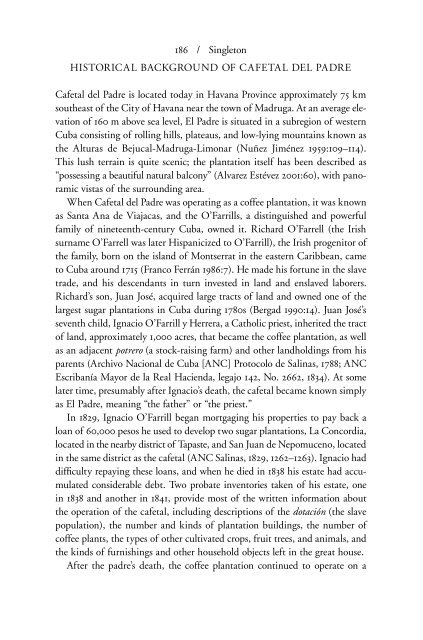Dialogues in Cuban Archaeology
by L. Antonio Curet, Shannon Lee Dawdy, and Gabino La Rosa Corzo
by L. Antonio Curet, Shannon Lee Dawdy, and Gabino La Rosa Corzo
You also want an ePaper? Increase the reach of your titles
YUMPU automatically turns print PDFs into web optimized ePapers that Google loves.
186 / S<strong>in</strong>gleton<br />
HISTORICAL BACKGROUND OF CAFETAL DEL PADRE<br />
Cafetal del Padre is located today <strong>in</strong> Havana Prov<strong>in</strong>ce approximately 75 km<br />
southeast of the City of Havana near the town of Madruga. At an average elevation<br />
of 160 m above sea level, El Padre is situated <strong>in</strong> a subregion of western<br />
Cuba consist<strong>in</strong>g of roll<strong>in</strong>g hills, plateaus, and low-ly<strong>in</strong>g mounta<strong>in</strong>s known as<br />
the Alturas de Bejucal-Madruga-Limonar (Nuñez Jiménez 1959:109–114).<br />
This lush terra<strong>in</strong> is quite scenic; the plantation itself has been described as<br />
“possess<strong>in</strong>g a beautiful natural balcony” (Alvarez Estévez 2001:60), with panoramic<br />
vistas of the surround<strong>in</strong>g area.<br />
When Cafetal del Padre was operat<strong>in</strong>g as a coffee plantation, it was known<br />
as Santa Ana de Viajacas, and the O’Farrills, a dist<strong>in</strong>guished and powerful<br />
family of n<strong>in</strong>eteenth-century Cuba, owned it. Richard O’Farrell (the Irish<br />
surname O’Farrell was later Hispanicized to O’Farrill), the Irish progenitor of<br />
the family, born on the island of Montserrat <strong>in</strong> the eastern Caribbean, came<br />
to Cuba around 1715 (Franco Ferrán 1986:7). He made his fortune <strong>in</strong> the slave<br />
trade, and his descendants <strong>in</strong> turn <strong>in</strong>vested <strong>in</strong> land and enslaved laborers.<br />
Richard’s son, Juan José, acquired large tracts of land and owned one of the<br />
largest sugar plantations <strong>in</strong> Cuba dur<strong>in</strong>g 1780s (Bergad 1990:14). Juan José’s<br />
seventh child, Ignacio O’Farrill y Herrera, a Catholic priest, <strong>in</strong>herited the tract<br />
of land, approximately 1,000 acres, that became the coffee plantation, as well<br />
as an adjacent potrero (a stock-rais<strong>in</strong>g farm) and other landhold<strong>in</strong>gs from his<br />
parents (Archivo Nacional de Cuba [ANC] Protocolo de Sal<strong>in</strong>as, 1788; ANC<br />
Escribanía Mayor de la Real Hacienda, legajo 142, No. 2662, 1834). At some<br />
later time, presumably after Ignacio’s death, the cafetal became known simply<br />
as El Padre, mean<strong>in</strong>g “the father” or “the priest.”<br />
In 1829, Ignacio O’Farrill began mortgag<strong>in</strong>g his properties to pay back a<br />
loan of 60,000 pesos he used to develop two sugar plantations, La Concordia,<br />
located <strong>in</strong> the nearby district of Tapaste, and San Juan de Nepomuceno, located<br />
<strong>in</strong> the same district as the cafetal (ANC Sal<strong>in</strong>as, 1829, 1262–1263). Ignacio had<br />
dif¤culty repay<strong>in</strong>g these loans, and when he died <strong>in</strong> 1838 his estate had accumulated<br />
considerable debt. Two probate <strong>in</strong>ventories taken of his estate, one<br />
<strong>in</strong> 1838 and another <strong>in</strong> 1841, provide most of the written <strong>in</strong>formation about<br />
the operation of the cafetal, <strong>in</strong>clud<strong>in</strong>g descriptions of the dotación (the slave<br />
population), the number and k<strong>in</strong>ds of plantation build<strong>in</strong>gs, the number of<br />
coffee plants, the types of other cultivated crops, fruit trees, and animals, and<br />
the k<strong>in</strong>ds of furnish<strong>in</strong>gs and other household objects left <strong>in</strong> the great house.<br />
After the padre’s death, the coffee plantation cont<strong>in</strong>ued to operate on a


















